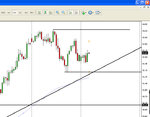SuperDriveGuy
Active member
- Messages
- 129
- Likes
- 1
Hi All,
Sorry, if this has been asked before, I have trawled through various posts with bits and pieces of information on trending and ranging markets. So I will make my questions very specific.
Q. How can one tell if a market is trending or ranging?
Some Background:- basing say on a 10min TF, is it as simple as saying when the 20 MA crosses above the 50 MA the market is trending and when the 20MA cops about the 50MA it is ranging? or is there more to it? The reason I ask the question, is I have a good system that works in ranging markets, but is an absolute disaster when the markets are trending. So my thinking is if I can determine when the market change from ranging to trending, I can stay out(OR I can come to the next question)
Q. Which are the "good" simple trend following systems?
Some Background:- again basing on a 10M TF, is it as simple as saying buy the pullback when the price is well above the 20MA, pullbacks to it and continues forward? Or buy the cross of the 20MA over the 50 MA etc? What does one do when the pullback is not actually a pullback but a reversal? so is not then a ranging market? or does one have to a X number of successive pullback to say the market is definitely trending? I understand that on different timeframes the market can be ranging and trending at the same time.
Any thoughts?
Thanks in advance.
Regards,
SDG
Sorry, if this has been asked before, I have trawled through various posts with bits and pieces of information on trending and ranging markets. So I will make my questions very specific.
Q. How can one tell if a market is trending or ranging?
Some Background:- basing say on a 10min TF, is it as simple as saying when the 20 MA crosses above the 50 MA the market is trending and when the 20MA cops about the 50MA it is ranging? or is there more to it? The reason I ask the question, is I have a good system that works in ranging markets, but is an absolute disaster when the markets are trending. So my thinking is if I can determine when the market change from ranging to trending, I can stay out(OR I can come to the next question)
Q. Which are the "good" simple trend following systems?
Some Background:- again basing on a 10M TF, is it as simple as saying buy the pullback when the price is well above the 20MA, pullbacks to it and continues forward? Or buy the cross of the 20MA over the 50 MA etc? What does one do when the pullback is not actually a pullback but a reversal? so is not then a ranging market? or does one have to a X number of successive pullback to say the market is definitely trending? I understand that on different timeframes the market can be ranging and trending at the same time.
Any thoughts?
Thanks in advance.
Regards,
SDG
Last edited:

